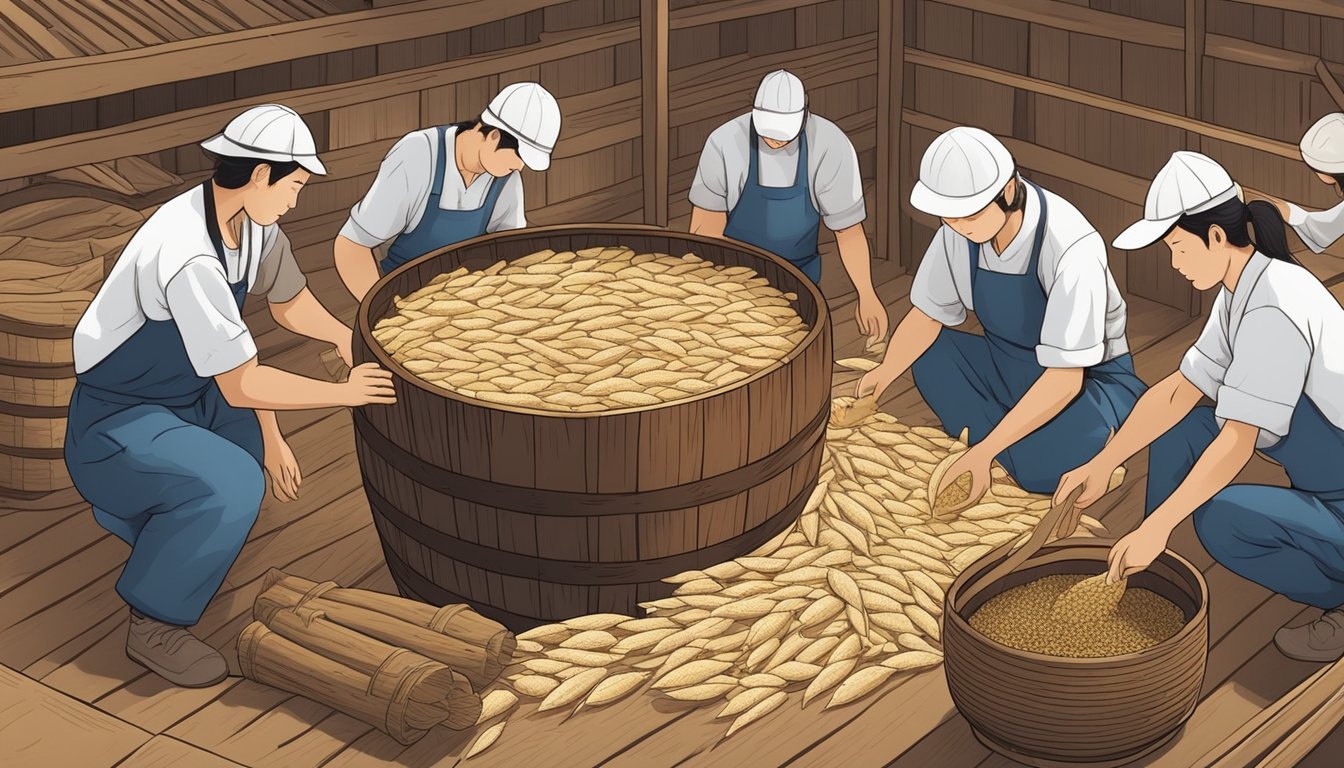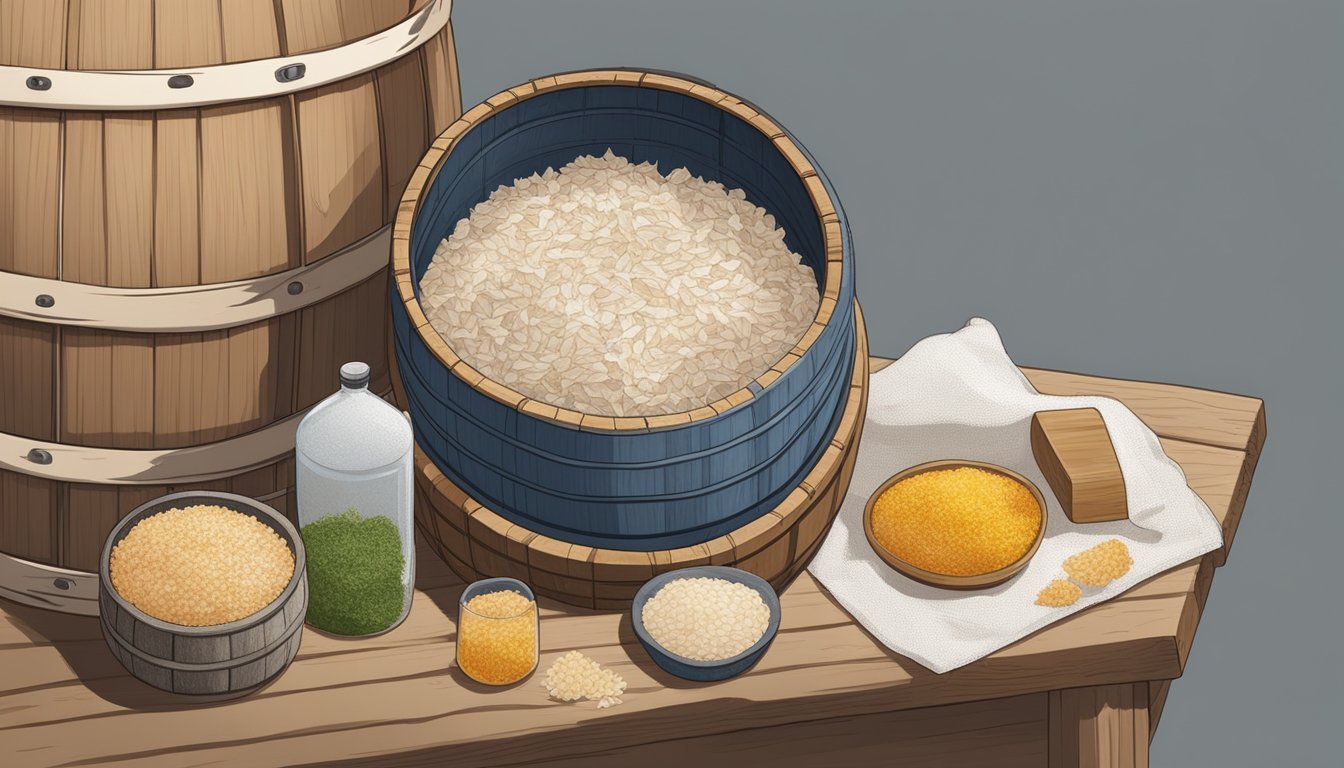How to Ferment Katsuobushi
Mastering Fermented Bonito Flakes at Home
Katsuobushi, integral to Japanese cuisine, is essentially dried and fermented bonito fish flakes renowned for their potent umami flavor. The process of making katsuobushi is meticulous and reflects centuries of culinary tradition. The initial stages involve filleting and simmering the bonito, followed by a thorough smoking and a unique fermentation phase, which cumulatively contribute to its distinctive taste and aroma.
The nuanced flavors of katsuobushi are deeply embedded in the Japanese culinary ethos, providing a foundation for the umami taste in many dishes. It is not merely a garnish but a vital component in creating the base for stocks like dashi, which underpins the flavor profile of soups, broths, and sauces.
Fermenting katsuobushi is a precision-driven process that demands patience and attention to detail. Once the bonito is smoked and dried to arabushi (the first stage of katsuobushi), it is carefully cultivated with a specific fungus. This fermentation not only heightens the umami but also enhances the longevity of the flakes, showcasing a marriage of technique and flavor that is hallmark to the finesse found in Japanese culinary practices.
The History and Cultural Significance of Katsuobushi
Katsuobushi is a cornerstone of Japanese cuisine, with its history rooted deeply in the country's culinary traditions. Originating centuries ago, katsuobushi began as a method to preserve fish by the Japanese, demonstrating their commitment to maximizing the use of seafood. It involves a precise fermentation process that enhances the flavor profile of skipjack tuna or bonito, transforming it into savory flakes integral to Japanese dishes.
During the Tokyo period, known as the Edo era historically, katsuobushi's significance magnified as Japan refined its culinary arts. This era saw an elevation of Japanese dining, with many traditional foods taking shape.
Katsuobushi played a significant role in the development of dashi, the quintessential stock that forms the base of countless Japanese recipes. Its unique umami flavor is irreplaceable, particularly in the making of miso soup, noodle broths, and various sauces.
Here's how it is produced and integrated into the culture:
Production: Katsuobushi is made by filleting bonito, followed by simmering, smoking, and then drying the fish to create hard blocks known as arabushi. The process can extend by cultivating mold on the dried fish, resulting in honkarebushi, which is then shaved into fine flakes.
Cultural Integration: These flakes are more than a mere ingredient; they represent Japan’s innovative preservation techniques and the philosophy of utilizing natural resources efficiently. It also showcases a balance of taste and nutrition, being rich in protein and essential amino acids.
As a cultural symbol, katsuobushi reflects the elegance and depth of Japanese gastronomy. Its resilient presence on the Japanese menu reveals an unwavering respect for both tradition and the meticulous art of food preparation.
Understanding the Basics of Katsuobushi
Katsuobushi is a fundamental ingredient in Japanese cooking, renowned for its rich flavor and health benefits. It forms the backbone of umami, the savory fifth taste that is crucial to the cuisine's distinctive taste profile.
Defining Katsuobushi
Katsuobushi is dried, fermented skipjack tuna that is finely shaved into flakes. The process involves filleting the fish, simmering, and then smoking it, resulting in what is known as arabushi. The next step involves fermentation with a specialized fungus which yields honkarebushi, known for its intense flavor.
Distinguishing Between Types of Katsuobushi
Arabushi: The smoked and dried form of katsuobushi without further fermentation.
Karebushi: An intermediate product that undergoes some level of drying and fermentation.
Honkarebushi: The highest grade of katsuobushi that is thoroughly dried and molded, often several times, to intensify its flavor.
Culinary Uses in Japanese Cuisine
Katsuobushi is widely used in Japanese cuisine as a topping, seasoning, and garnish. It adds depth and texture to dishes like:
Dashi: A staple stock that serves as a base for soups, stews, and sauces.
Okonomiyaki and Takoyaki: Savory pancakes and octopus balls garnished with katsuobushi.
Hiyayakko: Chilled tofu topped with katsuobushi. It can also be found in furikake (rice seasoning), miso soup, and on top of onigiri (rice balls).
Understanding Umami and Its Importance
Katsuobushi is rich in glutamate, one of the amino acids responsible for umami flavor. Umami enhances the overall taste experience by adding richness and complexity. It's a defining feature of many Japanese dishes, where layers of flavor are cultivated.
The Nutritional Benefits of Katsuobushi
Katsuobushi is not just flavorful but also packed with health benefits. It's a high-protein food with concentrations that can increase during the fermentation process up to 77%. Additionally, it offers:
Vital nutrients such as EPA for brain function and heart health.
Minerals like iron and niacin which help with blood pressure regulation and metabolism.
Evidence suggests regular consumption could contribute to a lower risk of diseases such as dementia, heart disease, and diabetes.
Preparation Techniques for Katsuobushi
The art of crafting Katsuobushi involves meticulous steps from drying and smoking bonito to delicate shaving methods that release its savory flavor and distinct aroma.
The Traditional Production Process
Katsuobushi production starts with filleting a bonito and simmering the pieces gently. Afterwards, they undergo a smoking process that enhances flavor and aids in preservation. The bonito is then left to dry and ferment. Fermentation is carried out by introducing Aspergillus glaucus, a beneficial mold, allowing the fish to develop a hard, wood-like texture and concentrate its flavor.
Shaving Katsuobushi
After the complete drying and fermentation, Katsuobushi is ready for shaving. It is traditionally shaved into flakes using a wooden box called "kezuriki" with a sharp blade. The shavings, known as "kezuri," should be thin, with an ideal thickness of 0.03 mm to 0.07 mm, to ensure the flakes dissolve easily when making broth or used as a garnish.
Making Dashi Broth with Katsuobushi
Dashi broth is a foundation of Japanese cuisine, prized for its clear, umami-rich flavor. To prepare katsuo dashi, add Katsuobushi flakes to boiling water and let it simmer briefly before turning off the heat. The ratio and timing are crucial — typically ⅔ oz of bonito flakes per 4 cups of water, simmered for just 30 seconds. This creates a stock with a deep aroma and a savory flavor.
Other Unique Uses of Katsuobushi in Cooking
Katsuobushi's utility extends beyond dashi broth. Its savory flavor and aroma make it an excellent topping for rice, noodles, and vegetables. It also serves as a flavor enhancer in sauces and can be sprinkled on food as a final touch to add a layer of umami.
Storage and Preservation Tips
Storing Katsuobushi properly is key to maintaining its quality. It should be kept in an airtight container to protect it from humidity and changes in texture. Ideally, storage in a cool, dark place helps preserve the flavor and aroma. If flakes remain, it's best to use them as soon as possible to enjoy their peak freshness.
Recipes and Application in the Kitchen
The versatility of Katsuobushi in culinary applications ranges from traditional Japanese dishes to innovative modern recipes. Its unique taste and substantial umami flavor due to rich amino acids make it a favorite amongst chefs.
Basic Recipes featuring Katsuobushi
Katsuobushi is fundamental in preparing dashi broth, an essential component in many Japanese recipes. For Basic Dashi:
Boil 4 cups of water.
Add ⅔ oz of Katsuobushi, boil for a few seconds, then simmer for 30 seconds.
Strain and use the broth.
Okaka, a simple rice topping, is made by mixing Katsuobushi flakes with soy sauce, and sometimes a little sugar, yielding a delightful combination for rice balls or onigiri.
Innovative Ways to Incorporate Katsuobushi
Chefs get creative by adding Katsuobushi as a flavor enhancer in:
Salads for a smoky accent.
Ponzu Sauce, blending Katsuobushi with citrus to create a complex dressing.
Finely powdered Katsuobushi as a furikake seasoning for rice or tofu dishes.
Expert Cooking Tips from Professional Chefs
Professional chefs suggest:
Gauging the thickness of Katsuobushi for desired texture; thinner for subtle taste, thicker for pronounced flavor.
Gently simmering Katsuobushi to avoid bitterness and preserve the delicate taste.
Pairing Suggestions with Beverages and Other Dishes
Katsuobushi complements light beverages like green tea or sake. It can also be paired with:
Noodles, adding a savory taste to broths.
Tofu, providing a flavor contrast to its mildness.
Homemade Katsuobushi and DIY Fermentation
To make homemade Katsuobushi, one must:
Obtain dried bonito flakes.
Control humidity and temperature to promote beneficial mold growth.
Safely ferment, following food safety standards to develop desired flavors.
Understanding the fermentation process is crucial as it concentrates the savory amino acids that enhance the characteristic taste of Katsuobushi.
The Science and Art of Katsuobushi Fermentation
The meticulous fermentation of katsuobushi is a multi-layered process that enhances the natural flavors and aroma, resulting in a rich umami profile. It involves carefully controlled environmental conditions and a symbiotic relationship with specific mold cultures.
Molecular Gastronomy of Fermentation
The transformation of bonito flakes into a complex, flavorful ingredient is governed by the molecular gastronomy of fermentation. Proteins within the katsuobushi are broken down into amino acids, which are the building blocks of umami flavor. These amino acids, particularly glutamate, contribute to the depth and savoriness that katsuobushi offers.
Understanding the Role of Mold in Fermentation
Aspergillus glaucus, a specific type of mold, is pivotal in katsuobushi fermentation. It works on the dried bonito flakes by breaking down residual fats and proteins, further intensifying the taste and contributing to a distinctive savory flavor. Mold not only aids in developing the aroma but also impacts the texture of katsuobushi.
Optimizing Environmental Conditions for Fermentation
The success of fermentation lies in optimizing environmental conditions. Humidity and temperature are meticulously regulated to ensure the mold thrives without spoiling the product. The bonito flakes are subjected to cycles of drying in the sun and fermenting in humidity-controlled rooms, which can take several months to effectuate the precise conditions for optimal fermentation.
The Influence of Katsuobushi on Food Science
Katsuobushi has significantly impacted food science with its ability to impart complex flavors to dishes. The umami flavor, a cornerstone of Japanese cuisine, owes much to the unique fermentation process of katsuobushi. The rich taste and aroma have become essential in the creation of dishes that require a boost in depth and flavor without overpowering other components.
Sustainability and Sourcing of Katsuobushi
In the context of katsuobushi, which is integral to Japanese cooking, the focus on sustainable practices and quality sourcing is crucial to preserve both ocean resources and culinary traditions.
Ethical Fishing and Sustainability of Skipjack Tuna
Skipjack tuna, the primary fish used for making katsuobushi, is harvested with attention to sustainable fishing methods to ensure the species' longevity. The sustainability of these fish stocks is managed by global organizations and national fishing policies that aim to prevent overfishing and to maintain a balanced ocean ecosystem.
Sourcing Quality Ingredients for Katsuobushi
Quality in katsuobushi begins with impeccable sourcing of skipjack tuna. Producers seek out the best specimens, often using traditional Japanese assessments of the fish's fat content and flesh quality. These parameters significantly affect the final flavor profile and texture of the katsuobushi.
The Future of Katsuobushi in Global Cuisine
As Japanese cuisine continues to influence the global culinary scene, the demand for katsuobushi is expanding. This rise in popularity prompts innovations in sustainable practices that could set a precedent for other global ingredients, ensuring that katsuobushi remains a staple in both traditional and modern cuisine.
Local and International Variations of Katsuobushi
International flavors have embraced katsuobushi, leading to variations that respect the traditional Japanese method while incorporating local tastes. This cross-cultural exchange not only diversifies the usage of katsuobushi in the global kitchen but also introduces a broader audience to the value of sustainability and quality in foreign food products.
Glossary and Terminology
Understanding the specific terminology associated with katsuobushi preparation and Japanese cuisine is crucial for appreciating the intricate process of fermenting bonito flakes and for recognizing the role they play in creating umami-rich flavors.
Key Terms in Katsuobushi Preparation
Katsuobushi: Dried, fermented and smoked bonito (skipjack tuna) flakes; a fundamental ingredient in Japanese cooking providing a savory umami flavor.
Kezuri: The process of shaving katsuobushi blocks to create the flakes.
Kezuriki: The tool used for shaving katsuobushi into fine flakes.
Honkarebushi: Katsuobushi that has been further fermented with mold, a category under which high-quality katsuobushi falls.
Kabitsuke: The process of smoking and drying bonito to make katsuobushi.
Hanakatsuo: Thinly shaved katsuobushi, resembling flower petals, used as a garnish or flavoring in Japanese dishes.
Honenuki: The removal of bones from the bonito fish before the fermentation process.
Definitions of Common Japanese Culinary Terms
Dashi: A fundamental Japanese soup stock infused with umami, often made by simmering katsuobushi and kombu (kelp).
Umami: The savory taste, recognized as one of the five basic tastes, ubiquitous in Japanese cuisine, especially noted in katsuobushi.
Kombu: Edible kelp used to prepare dashi, contributing to the umami flavor profile.
Mirin: A sweet Japanese rice wine used for cooking, often paired with soy sauce.
Ponzu Sauce: A tart, citrus-based sauce commonly used in Japanese dishes for added flavor.
Shiitake Mushrooms: Edible mushrooms native to East Asia, prized for their rich flavor and used to enhance the savory taste in Japanese cooking.
Frequently Asked Questions
This section aims to provide clear answers to common inquiries about katsuobushi, address potential issues during its preparation, and present creative recipe ideas incorporating this flavorful ingredient.
Common Queries About Katsuobushi
What is Katsuobushi?
Katsuobushi refers to dried bonito fish flakes, often used in Japanese cooking to enhance flavor, primarily known for its essential role in creating dashi, a fundamental stock.
How is Katsuobushi made?
It is crafted by simmering, smoking, and drying bonito fish, after which it may be fermented with specific fungi to develop its distinct taste.
What is the nutritional value of Katsuobushi?
Katsuobushi is rich in protein and contains various minerals, contributing to its nutritional benefits when added to the diet.
How should Katsuobushi be stored to maintain its quality?
To ensure proper storage, keep it in a cool, dry place, sealed to prevent moisture and preserve its quality and shelf life.
Troubleshooting Katsuobushi Preparation
Why does my Katsuobushi lack flavor?
Insufficient curing time or incorrect storage may diminish its rich taste. Ensure it is well-preserved and used promptly.
Using an inadequate amount in recipes can lead to a less pronounced flavor. Adjust quantities based on recipe guidelines.
How can one avoid common preparation mistakes with Katsuobushi?
Ensure the flakes are not boiled for too long, as this will cause the flavor to dissipate.
Avoid using overly high heat when incorporating it into dishes, as it can alter the intended taste.
Innovative Uses and Recipe Ideas
Beyond dashi, how can Katsuobushi enhance other recipes?
Katsuobushi can be used to season rice, mixed with nori and sesame seeds, and as a topping for salads and tofu dishes to add a savory depth.
Can Katsuobushi be included in non-traditional dishes?
Its umami-rich quality makes it flexible for various culinary experiments, from enhancing soups and sauces to being used as a unique garnish on western dishes.
What are some cooking tips for using Katsuobushi in everyday meals?
For a quick and simple flavor boost, sprinkle it over hot rice or incorporate it into omelets.
Creatively pair it with vegetables to elevate the dish's overall taste profile.
Conclusion
Katsuobushi stands as a cornerstone of Japanese cuisine, contributing significantly to the revered umami flavor that defines many dishes. Fermented bonito flakes are not just a garnish but an ingredient pivotal for creating the depth of flavor in dashi, the foundational broth that enhances soups, sauces, and various other culinary creations.
In the preparation of katsuobushi, artisans adhere to a meticulous fermentation process that ultimately augments its flavor profile. This traditional technique ensures that katsuobushi preserves not only its flavor but also its nutritional value. With a high protein content and an ensemble of essential amino acids, vitamins, and minerals, katsuobushi is both healthful and flavorful.
When integrated into dishes, it imparts an unmistakable savoriness, elevating simple ingredients to new heights. Whether consumed in thin shavings atop rice or dissolved in broths, the bold umami of katsuobushi is undisputed.
It is essential to respect the craftsmanship behind katsuobushi and to incorporate it into cooking with mindfulness of its cultural legacy. Chefs and home cooks alike recognize the unparalleled role that these fermented bonito flakes play in their culinary repertoire, solidifying its status as a revered element of Japanese cuisine.






